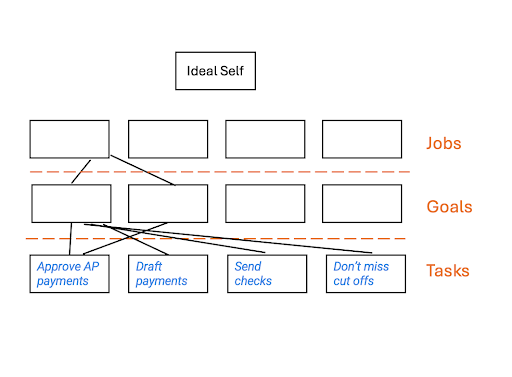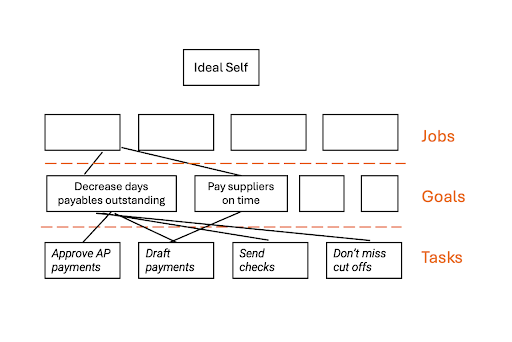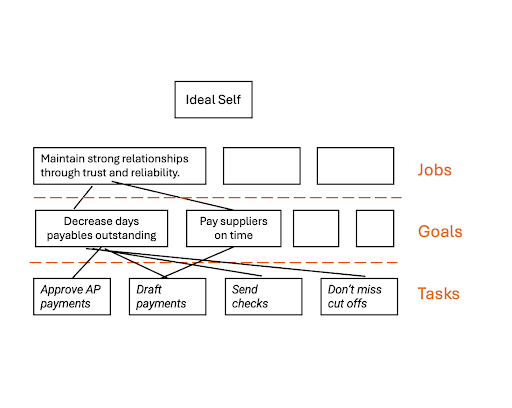If you’re a person who creates value for people with technology, you’ve probably heard of the Jobs-to-be-Done (JTBD) theory. Maybe you’ve even observed the same phenomenon that I have: That, as the theory has gained popularity in its application to innovation, well-meaning teams have begun uncovering their customers’ tasks and goals, and calling them Jobs, as if waiting for some magic to happen.
3 Steps to Apply Jobs-to-Be-Done Theory in B2B
- Identify your users influencers and decision makers.
- Don’t be afraid to ask questions that seem out of scope.
- Read between the lines.
Don’t get me wrong, uncovering tasks and goals is wonderful. It’s customer-centric. It’s indeed an important part of product development. But, importantly, it’s not jobs. Why does that matter? It’s important because jobs has real magic to offer. So, if you want to spread that magic, or you yourself are confused about the difference between a task, a goal and a job, keep reading.
What Is the Jobs-to-be-Done Theory?
The Jobs-to-be-Done (JTBD) theory is an explanation of human behavior, specifically how and why people buy some things and not other things. It’s useful for all innovators because it helps us think bigger and broader about the problems we’re solving for customers. It does this in two ways:
- It focuses us on outcomes, what customers actually want to achieve, and reminds us that our product is just a means to that end and not the end in itself.
- While outcome-driven innovation is not unique to JTBD, the theory takes us further. It reminds us that these outcomes are often deeper than they may appear and rooted in the universal human need to make progress in our present states.
I think about jobs as ideal state feelings. I’ve found this helps distinguish jobs from tasks or goals. And this isn’t just my opinion. The theory is grounded in the belief that a task is never just a task, there’s a deeper motivation rooted in the fulfillment of an ideal self. I currently feel one way, so I “hire” this product to feel this desired way. That “desired feeling” is the job.
For example, Dave, the fintech company, doesn’t define its business too narrowly. It’s in the business of helping customers make progress on their money. This includes saving money and making it.
The JTBD statement might look like this: “When I feel [out of control with my money], I “hire” Dave’s “Side Hustle,” so that I can [feel in control of my finances].” The job is feeling in control of one’s money. And a product like “Side Hustle,” which helps customers earn extra income, is suddenly not out of scope at all.
But if jobs are feelings, are they applicable to B2B markets where rational value, ROI and efficiency rule?
Can the Jobs-to-Be-Done Theory Be Applied to B2B?
In the context of enterprise software, is a task ever more than just a task? B2B is still just people to people, and people are emotional.
As it turns out, emotions aren’t just involved in B2B purchasing decisions, they’re even more heightened than for consumer purchases. And, as is so often the case with research, that truth now seems so obvious.
Business purchases involve higher stakes, higher risk and much more money. And, in addition to business performance, powerful, emotionally driven needs are present: a desire for recognition, such as a promotion, or fear of a rejection, like a job loss.
Google, in partnership with CEB Marketing, found that “B2B purchasers are almost 50 percent more likely to buy a product or service when they see personal or emotional value.” But according to the same study, and primary research I’ve conducted, most B2B campaigns and experiences underdeliver on these dimensions.
So, now that we know emotions indeed play a role in B2B purchasing, we know that we can leverage JTBD to help us innovate. Focusing too narrowly on the tasks customers are doing with your products, without thinking about what those customers are trying to achieve, puts your product at risk of disruption. Your product, and the tasks your users complete with your product, are a means to an end. What is the end?
How the JTBD Theory Can Be Applied to B2B
Author Alan Klement, in his book on JTBD, When Coffee & Kale Meet, helps us apply William T. Powers’ Motivational Hierarchy of Goals. We understand that simple motor control goals, like slicing broccoli, ladder up to do goals, like cooking dinner, which ladder up to be goals, like being thoughtful.
B2B teams often stop at “do goals” and focus too narrowly on “motor control goals.” Understanding those “be goals” through JTBD can help us better serve our business customers.
And because jobs are ideal state feelings, the set of all possible jobs is not only finite, but relatively, quite small.
Making a distinction between tasks that business customers actually want to spend time on versus tasks that are tedious is critical to understanding the JTBD theory. It helps us identify what the task is in service of and when the task is the Job, or something people want to spend time on. Efficiency, and increasingly automation, is the target for many business tasks. But which, if any, tasks are enjoyable? Do you know which parts of the job your customers want to spend time on?
3 Steps to Apply the Jobs-to-Be-Done Theory to B2B
1. Identify Your Users, Influencers and Decision Makers
While I like to say JTBD is all about “situation over segment,” meaning understanding your customer’s context of use is more important than any demographic or similar segmentation technique, we haven’t uncovered our jobs, or situational drivers, yet. So, it’s helpful to start by grouping customers. It’s important to cover the variability of people involved in B2B purchasing decisions. Start by thinking about your customers in three broad groups, users, influencers and decision makers. You might have subgroups within each of these groups that share a relevant behavior or role.
2. Don’t Be Afraid to Ask Questions That Seem Out of Scope
During the interview, don’t be afraid to ask questions that might seem out of scope. Don’t just ask about tasks, goals and tools, ask about long-term goals, personal goals and areas of personal growth. And don’t shy away from job changes, crazy dreams or fears. What keeps your customers up at night? What brings them joy? What do they love about their jobs? What do they absolutely hate about them? How did they find themselves in their jobs?
3. Read Between the Lines
What’s so fascinating about JTBD is that because they aren’t always explicitly stated, not everyone will pick up on them. Rarely do customers think as much about their own behavior and motivations as people who build things for people do. This means we have to read between the lines.
Jobs to Be Done Theory in Action
Let’s use an accounts payable manager as an example to help us differentiate tasks, goals and jobs. If you’re only looking for tasks you might come away from your interviews with the following:

You will probably hear goals as well that the tasks you’ve identified ladder up to:

But if you ask the right questions, and allow yourself to consider the emotion, you can pick up on things that others may miss or toss to the side:
- “I want to pay vendors on time and I won’t leave my office until I know I’m going to be able to.”
- “But it’s hard if I have a thousand invoices and I don’t know if I am paying the right person. Or paying the same person twice. I’m reliant on pieces of paper. And paper gets misplaced all the time.”
- “Suppliers won't say anything, but if I pay late, they won’t want to work with me again. Money is not the issue.”
- “There are vendors who work with me because they know I’m honest. They know they can trust me.”
Understanding their goals might help you consider higher-order jobs, appealing to emotions, like pride:

Uncovering the jobs that your B2B offering is hired to do can help everyone on your team more deeply understand what your customers really care about. And when you understand what your customers really care about, and you think of what you’re delivering to your customers as that feeling, not whatever your current product is, you’ve created a fertile ground for innovation. And most importantly, you’ve gotten your team to empathize with your customers. I end on this note because if I leave you with nothing else, I want it to be empathy. Because that is the real magic of jobs.





